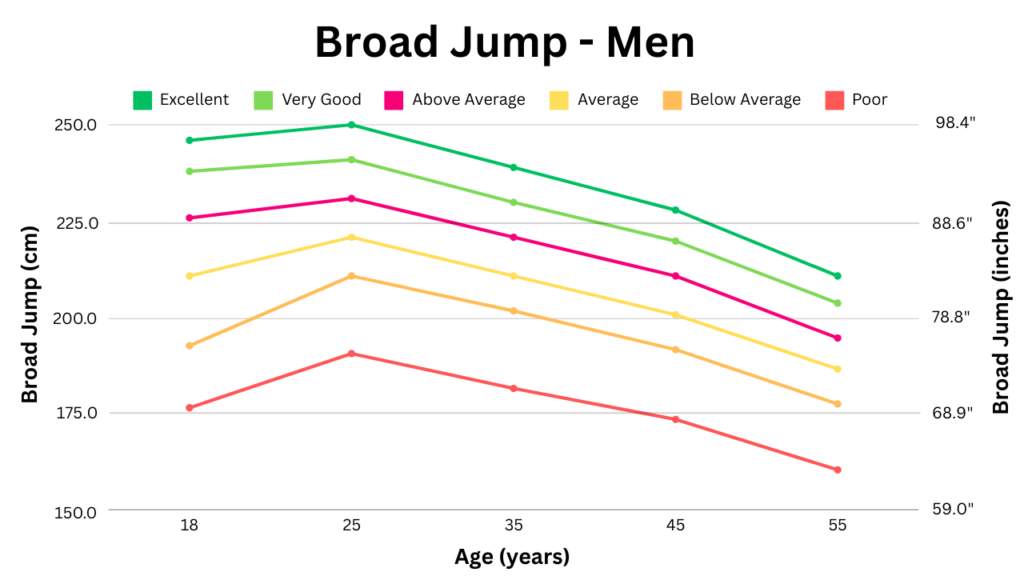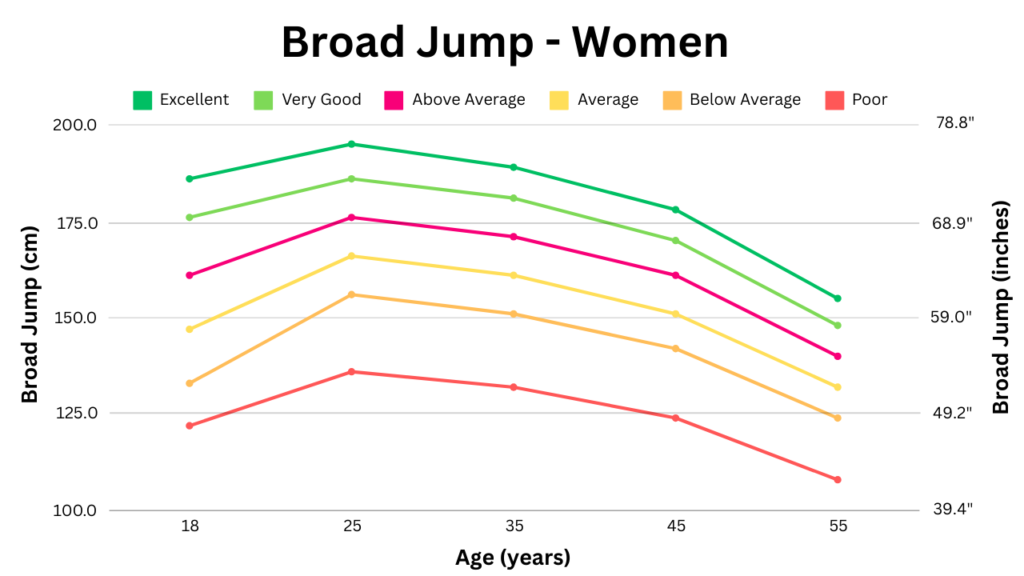Your broad jump is the maximum distance you can jump from a standing position. It is a good way to assess your lower body power relative to your body-weight. All you need is a tape measure and an 8-10 minute warm up.
How To Measure Your Broad Jump
Measuring the broad jump is very simple and can be done on many surfaces, though the safest is jumping into a sand pit. As it is an explosive exercise with a very forceful landing, it should be preceded by a very thorough warm up.
Jumping into a Sand Pit
If you have access to a sand pit*, that is a great way to measure your broad jump. Firstly, set up with feet shoulder width apart on the edge of the pit. Don’t hang your toes off the end as that allows additional force to be applied and would be considered cheating. From there, try to jump as far as you can into the pit. Measurement should be from the edge of the pit to the rearmost mark in the sand. Ideally this would be made by the feet or bum and not by a stray hand. Smoothing the sand out before the jump makes it clearer where you leave your mark.
*By sand pit, I mean a long/triple jump pit at an athletics track, not one for home use

Jumping onto the Ground
If you don’t have access to a pit, you will need to find an appropriate surface to jump on. As long as it’s short and dry, grass is often a sensible option. Carpet may also be suitable as long as there’s no danger of slipping. I do mine on a hard patio following years of sprint training, so I know my body can handle the impact. If you aren’t sure, try a 50% effort jump and then gradually put in more effort to get a feel for the surface.
As for the jump itself, you will need to land on your feet and aim not to move after landing. This allows you to make the most accurate measurement of the distance covered. You are measuring from the front of the foot at takeoff to the back of the foot on landing. This catches a lot of people out, and is in some ways unfair, as it negates the length of your shoe. I set out the tape measure and position my toes at the zero mark (0 centimetres). This way, I can immediately see where my heel aligns with on the tape when I land.

Jumping Technique
While it is a good measure of lower body power, the distance you travel can vary a lot by how skilled you are at jumping. It may not seem like something that needs a lot of practice, but there are huge gains with the right focus on execution. My technique may not be the best but it hopefully illustrates some of the key points, as shown below.
As I see it, the key points are as follows:
- Feet should be roughly shoulder distance apart. I once read that the ideal stance is the natural one you would land in following a moderate vertical jump.
- Swing the arms. An emphasis on speed both in the back swing and the forward propulsion. I like to think of “throwing” my arms forward to generate extra distance.
- Hip extension. This varies based on how much time you have in the air, but a nice full extension of the hips is the aim.
- Safe landing. If you are landing on a harder surface, make sure you aren’t landing with discomfort. I like to warm up with 80%, 90% and 95% efforts before I do a full broad jump just to be sure my feet can handle it.
Warming up
As this is an explosive movement, it’s recommended that you complete a thorough warm up prior to the test. I have recorded an 8 minute dynamic warm up that can be seen below.
It can help as part of the warm up to do a few practice jumps at 80-90% effort to get a feel for the best technique. This also serves to reduce the risk of injury as you are building up the intensity gradually.
What Do My Results Mean?
The broad jump standards below were created from a combination of normative data sources. Sources tend to either report average values by age or standards for a single age group. I’ve had to extrapolate, based on the assumption that the percentage difference between “Good” and “Poor” efforts is maintained across all age groups.

The most obvious difference between the two charts is that, on average, men jump around 50cm further. Elite male athletes are capable of jumping beyond 3 metres (118 inches). As this graph is for the general population, anything above 250cm (98 inches) is considered “Excellent”. Muscle strength and power are lost at a faster rate than muscle mass with age, equivalent to ~1% per year.

Tracking over time
While this isn’t an essential test to track with age, it’s perfectly reasonable to assess yourself every year and track your progress. Alternatively, measuring every 3 to 5 years will allow you to measure your loss of power with age.
There is a skill element to a broad jump that comes through practice. With that in mind, you may find the difference across 3 years of testing to be the same as what you might see from consecutive jumps. If that’s the case, you may wish to have multiple attempts and take your best effort, rather than relying on a single jump.

